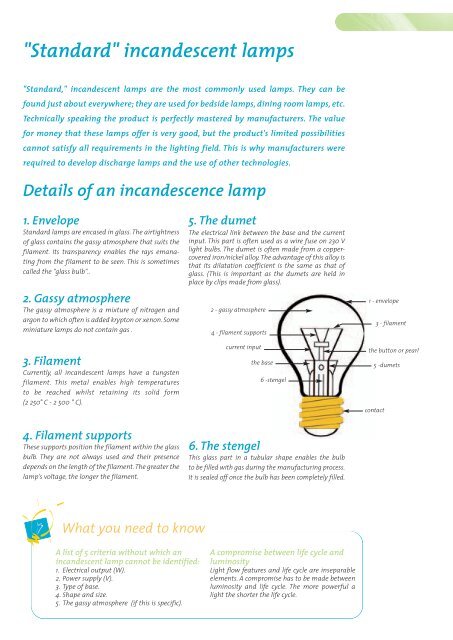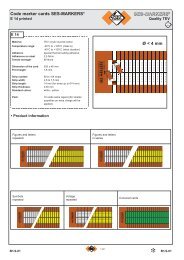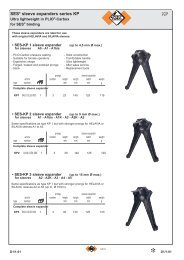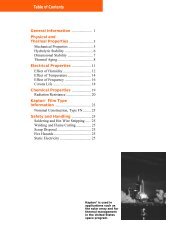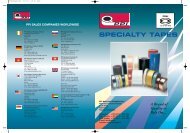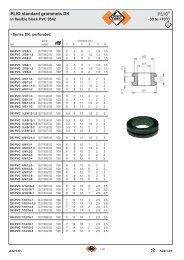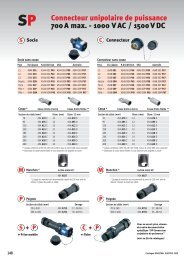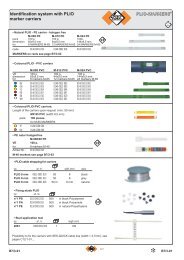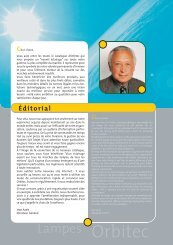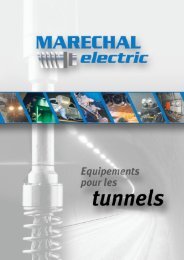Incandescent lighting - Palissy Galvani
Incandescent lighting - Palissy Galvani
Incandescent lighting - Palissy Galvani
You also want an ePaper? Increase the reach of your titles
YUMPU automatically turns print PDFs into web optimized ePapers that Google loves.
"Standard" incandescent lamps<br />
"Standard," incandescent lamps are the most commonly used lamps. They can be<br />
found just about everywhere; they are used for bedside lamps, dining room lamps, etc.<br />
Technically speaking the product is perfectly mastered by manufacturers. The value<br />
for money that these lamps offer is very good, but the product's limited possibilities<br />
cannot satisfy all requirements in the <strong>lighting</strong> field. This is why manufacturers were<br />
required to develop discharge lamps and the use of other technologies.<br />
Details of an incandescence lamp<br />
1. Envelope<br />
Standard lamps are encased in glass. The airtightness<br />
of glass contains the gassy atmosphere that suits the<br />
filament. Its transparency enables the rays emanating<br />
from the filament to be seen. This is sometimes<br />
called the "glass bulb"..<br />
2. Gassy atmosphere<br />
The gassy atmosphere is a mixture of nitrogen and<br />
argon to which often is added krypton or xenon. Some<br />
miniature lamps do not contain gas .<br />
3. Filament<br />
Currently, all incandescent lamps have a tungsten<br />
filament. This metal enables high temperatures<br />
to be reached whilst retaining its solid form<br />
(2 250° C - 2 500 ° C).<br />
4. Filament supports<br />
These supports position the filament within the glass<br />
bulb. They are not always used and their presence<br />
depends on the length of the filament.The greater the<br />
lamp's voltage, the longer the filament.<br />
5. The dumet<br />
The electrical link between the base and the current<br />
input. This part is often used as a wire fuse on 230 V<br />
light bulbs. The dumet is often made from a coppercovered<br />
iron/nickel alloy. The advantage of this alloy is<br />
that its dilatation coefficient is the same as that of<br />
glass. (This is important as the dumets are held in<br />
place by clips made from glass).<br />
2 - gassy atmosphere<br />
4 - filament supports<br />
current input<br />
the base<br />
6 -stengel<br />
6. The stengel<br />
This glass part in a tubular shape enables the bulb<br />
to be filled with gas during the manufacturing process.<br />
It is sealed off once the bulb has been completely filled.<br />
1 - envelope<br />
3 - filament<br />
the button or pearl<br />
5 -dumets<br />
contact<br />
What you need to know<br />
A list of 5 criteria without which an<br />
incandescent lamp cannot be identified:<br />
1. Electrical output (W).<br />
2. Power supply (V).<br />
3. Type of base.<br />
4. Shape and size.<br />
5. The gassy atmosphere (if this is specific).<br />
A compromise between life cycle and<br />
luminosity<br />
Light flow features and life cycle are inseparable<br />
elements. A compromise has to be made between<br />
luminosity and life cycle. The more powerful a<br />
light the shorter the life cycle.


